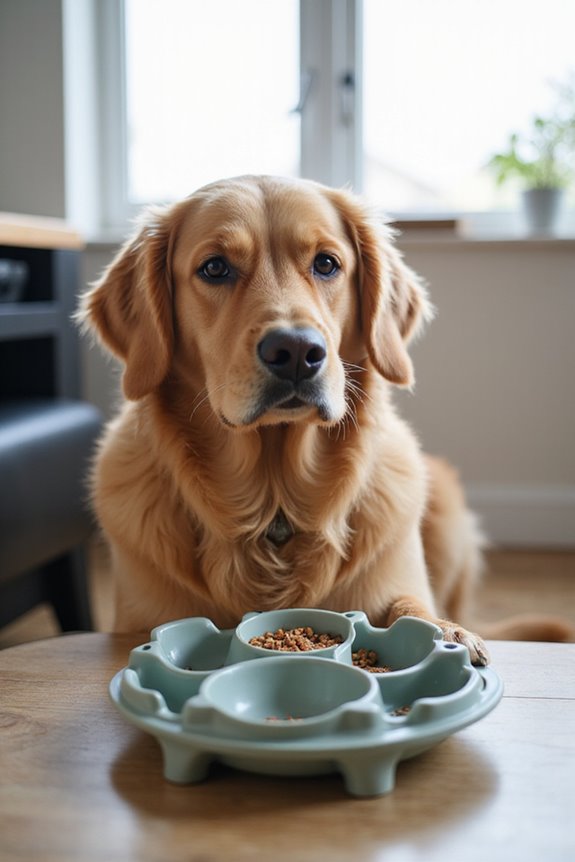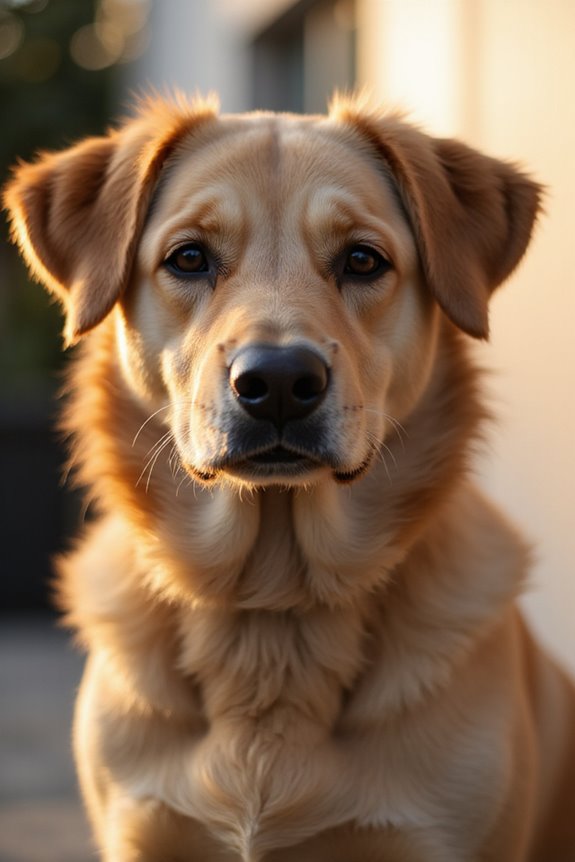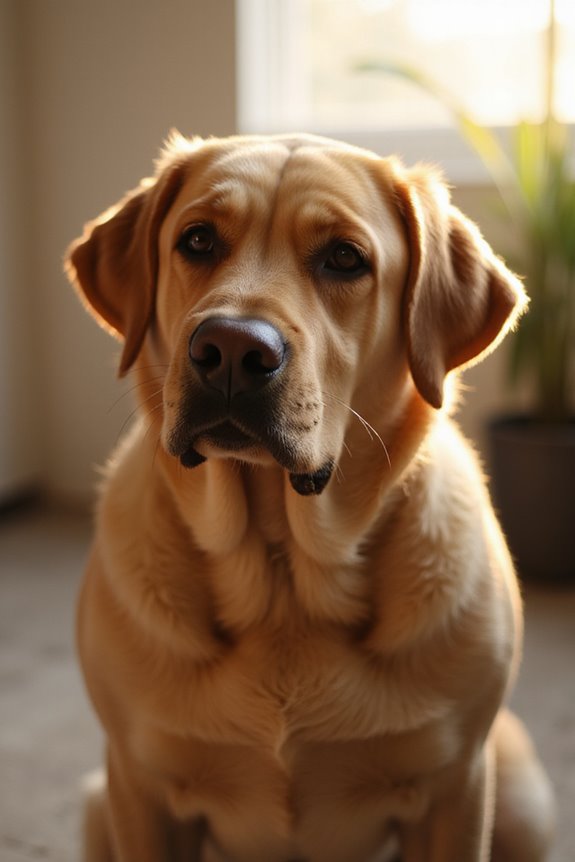If you have a fast-eating dog, slow feeder bowls are essential to promote safer, more mindful eating habits. Look for models with features like raised grooves or maze-like designs that prevent gulping. Materials such as stainless steel are durable and easy to clean. Important considerations include bowl size to fit your dog’s breed and a non-slip base to prevent tipping. Gradually introducing these bowls can ease the shift and enhance mealtime experience. For further insights, consider our detailed examination of options.
Key Takeaways
- Choose bowls with maze-like designs or obstacles to promote slower eating habits and enhance mental engagement during mealtime.
- Select non-slip bowls to prevent tipping and spills, providing stability for enthusiastic eaters.
- Look for durable, easy-to-clean materials like stainless steel for long-lasting use and hygiene.
- Ensure the bowl size matches your dog’s breed and meal capacity for optimal performance during feeding.
- Gradually introduce a slow feeder bowl to your dog to avoid frustration and encourage a positive association with new feeding methods.
Understanding the Need for Slow Feeder Bowls
While fast-eating dogs may seem to be just a minor inconvenience, their rapid consumption can lead to serious health issues, making the need for slow feeder bowls quite evident. These bowls incorporate features that promote slow eating, fundamentally altering dog behavior during mealtime.
Key design aspects include:
- Obstacles like ridges or mazes that force dogs to navigate for their food.
- Segmented surfaces to space out food, preventing gulping.
- Varied complexity tailored to different breeds, ensuring engagement without frustration.
Choosing the right slow feeder bowl can greatly enhance your dog’s eating experience, transforming it from a hurried event to a thoughtful process. This enhanced mealtime engagement not only supports safety but also enriches your dog’s mental stimulation considerably. Additionally, slow feeder bowls can reduce risks of choking and promote healthier eating habits across all life stages.
Health Benefits of Using Slow Feeder Bowls
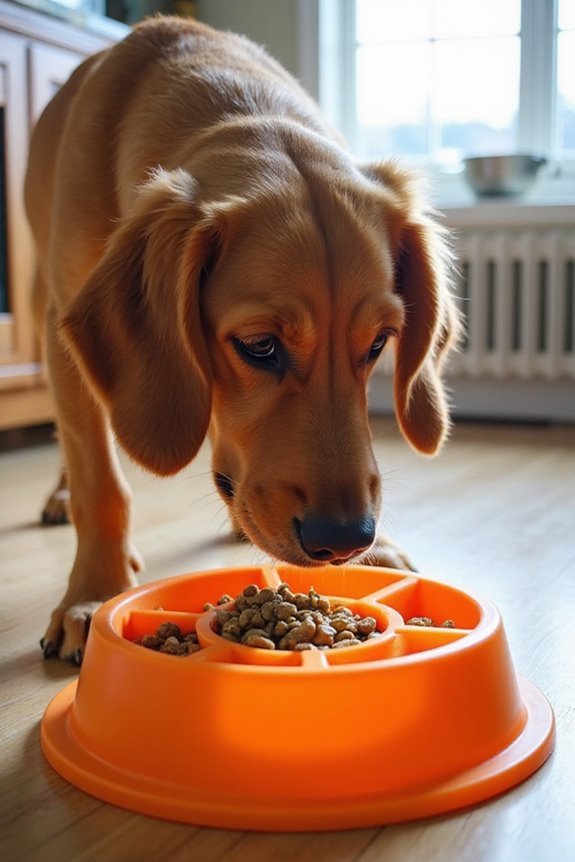
The implementation of slow feeder bowls greatly contributes to a dog’s health and well-being by addressing various issues associated with fast eating. These bowls promote mindful eating, aiding in bloating prevention and enhancing digestive health. By reducing gulping, dogs experience fewer digestive disorders and gastrointestinal discomfort, leading to improved nutrient absorption.
Additionally, slow feeders foster mental stimulation, encouraging dogs to engage with their food, which can enhance behavioral benefits and reduce anxiety during mealtimes. They also support portion control and weight management by promoting smaller mouthfuls and decreasing the likelihood of overeating. Overall, using slow feeders can greatly improve eating habits and safety concerns, ensuring a calmer, more enjoyable mealtime experience for both pets and owners.
Key Features to Look for in Slow Feeders
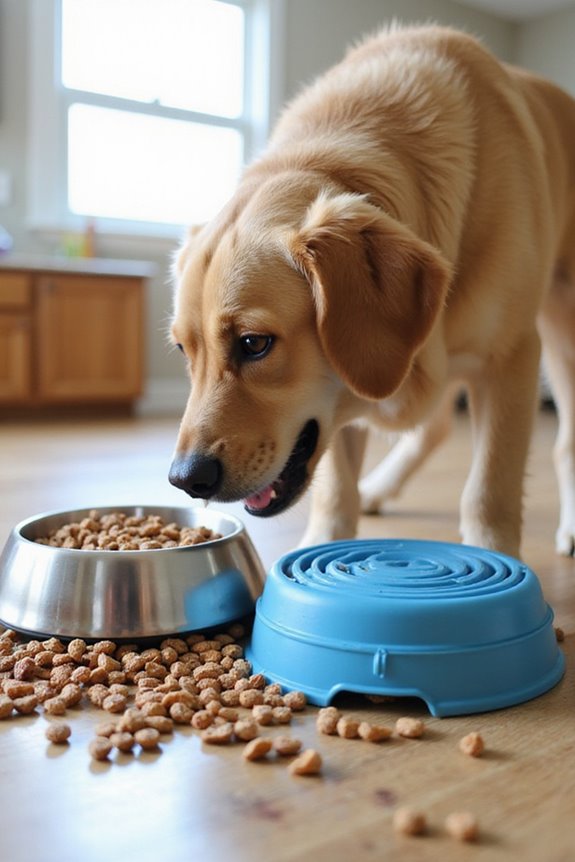
Choosing the right slow feeder bowl is essential for guaranteeing your dog’s mealtime is both safe and enjoyable. When selecting one, here are key slow feeder features to take into account:
- Material Variety: Opt for durable materials like stainless steel, which are easy to clean and long-lasting.
- Size and Capacity: Make sure the bowl fits your dog’s breed and can hold a full meal.
- Non-Slip Base: This prevents the bowl from tipping, promoting a stable eating experience.
- Bowl Design: Look for maze-like structures that slow down eating, or features like customizable inserts for different food types.
- Easy Cleaning: Many models are dishwasher-safe, making maintenance straightforward.
With these factors in mind, you’ll find a slow feeder that meets both your needs and your dog’s.
Popular Slow Feeder Bowl Models
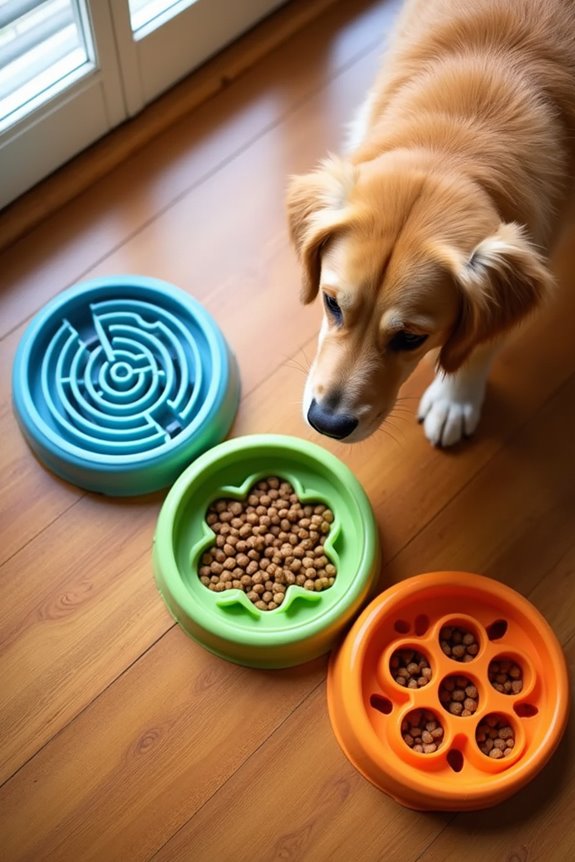
After considering the key features of slow feeders, it’s important to explore specific models that exemplify effective design and functionality. Here are some popular slow feeder bowl models that accommodate various eating styles:
- Super Design Gobble-Stop Bowl
- Features three raised grooves.
- Multiple size options (100 ml to 1200 ml).
- Non-slip base guarantees stability.
- Maze-like interior for added challenge.
- Broad sizes and colors available.
- Focus brings mental stimulation.
- Durable with bone-shaped ridges.
- Budget-friendly under $10.
- Shallow depth fits flat-faced dogs.
- Suitable for both dogs and cats.
- Durable design prolongs feeding time.
- Prone to scratches, leading to bacterial buildup.
- May leach harmful chemicals into food or water, especially under heat.
- Degrades over time, requiring more frequent replacements.
- Highly durable and resistant to rust or breaking, making it ideal for daily use.
- Its non-porous surface prevents bacteria, making it safer and more hygienic.
- Free from BPA and other hazardous substances, it’s a healthier option for dogs, particularly those with allergies.
- Frequency: Clean food bowls after every meal and water bowls daily to prevent bacterial growth.
- Weekly Deep Clean: Disinfect both types of bowls using a diluted vinegar solution or pet-safe disinfectants.
- Effective Techniques: Use warm water and mild dish soap, scrubbing thoroughly, then rinse completely to remove soap residue.
- Drying: Always dry bowls completely before reuse to avoid moisture-related bacteria.
- Small Dogs: Bowls holding 5 to 6.5 ounces, around 5 x 1.5 inches.
- Medium Dogs: Bowls for 2 to 4 cups, typically deeper than small bowls.
- Large Dogs: Bowls that accommodate 4 to 8 cups, designed for bigger muzzles.
- Giant Breeds: Bowls greater than 50 ounces, with dimensions above 5 x 2.4 inches.
- Material Durability: Stainless steel options are indestructible and easy to clean.
- Versatility: Multi-functional bowls support various food types and make mealtime more engaging.
- Complexity Levels: Adjustable designs cater to your dog’s individual eating speed and behavior, fostering healthier habits over time.
- Calm Environment: Minimizes noise from metal bowls.
- Predictable Routine: Encourages consistent bowl placement.
- Improved Digestion: Creates a secure eating environment, beneficial for anxious dogs.
- Hygiene Maintenance: Prevents spills that attract pests.
- Durability: Often integrated with sturdy materials to withstand wear.
- Support for mobility issues: Non-slip bowls can help dogs with mobility issues access their food more easily.
These design variations effectively promote slower eating habits, benefiting fast eaters considerably.
Material Comparisons: Plastic vs. Stainless Steel
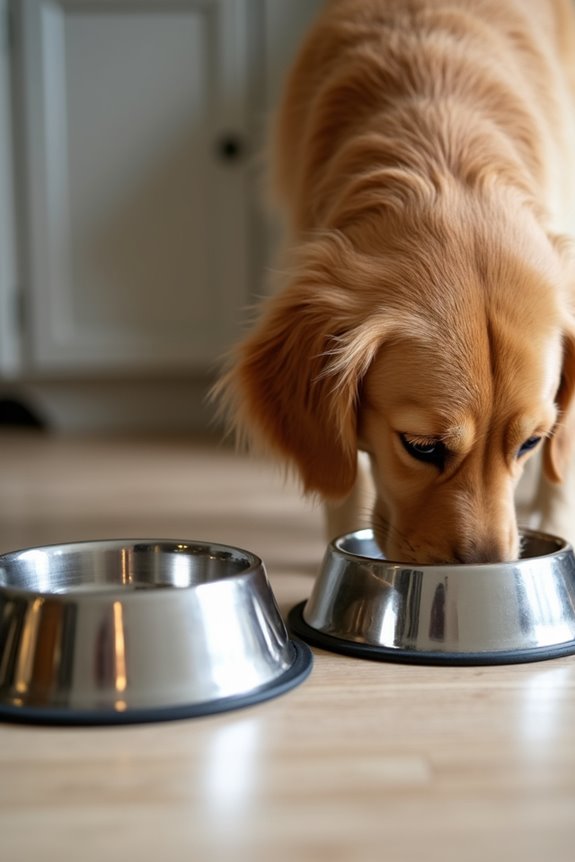
When considering the best materials for dog bowls, a comparison between plastic and stainless steel reveals significant differences that can impact both your dog’s health and the longevity of the product.
Plastic Disadvantages:
Stainless Steel Advantages:
Ultimately, investing in stainless steel can benefit both you and your dog in the long run.
Maintenance and Cleaning Considerations
Maintaining proper hygiene for your dog’s bowls is essential, and adhering to a consistent cleaning schedule can greatly enhance your pet’s health. Here are some important maintenance routines to keep in mind:
Selecting the Right Size for Your Dog
Selecting the right bowl size for your dog is essential for their comfort and feeding efficiency. When considering bowl dimensions, think about your dog’s size.
Bowl height is equally important; it should match your dog’s leg height for ergonomic eating. For instance, larger breeds like Great Danes may need bowls around 16 inches high to promote comfortable feeding and better digestion.
Addressing Unique Eating Habits With Design Choices
Choosing the right bowl size is just the beginning of accommodating unique eating habits in dogs. The design of a bowl plays a significant role in addressing your pet’s eating psychology and feeding patterns. For example, slow feeder bowls with maze-like structures compel dogs to navigate obstacles, slowing their intake and promoting better chewing. This thoughtful approach helps alleviate issues like bloating and gas, tied to rapid consumption.
When selecting a bowl, consider:
The Role of Non-Slip Features in Effective Feeding
Effective feeding for dogs goes beyond merely selecting the right food; it also involves incorporating features that enhance the dining experience. Non-slip benefits are essential for providing feeding stability, ensuring your dog’s bowl stays put during meals. This stability reduces stress for dogs, allowing them to focus on eating instead of chasing a sliding bowl.
Here are key advantages of non-slip features:
Investing in non-slip bowls can transform your dog’s feeding experience, promoting both comfort and cleanliness.
Tips for Transitioning Your Dog to a Slow Feeder Bowl
Shifting your dog to a slow feeder bowl can be a straightforward process, provided you approach it systematically. Here are some effective change strategies and feeding techniques:
- Initial Familiarization: Place the slow feeder bowl next to the regular one.
- Gradual Introduction: Start using the slow feeder for one meal per day, introducing it gradually.
- Confidence Boost: Use simpler designs to encourage your dog.
- Positive Associations: Add a small amount of current food to the slow feeder.
- Monitor Reactions: Watch for signs of frustration.
- Food Change: Mix 75% old food with 25% new initially, increasing to 100% new over a week.
- Encouragement: Use treats and praise to foster interaction.
Frequently Asked Questions
Can Slow Feeder Bowls Prevent Food Aggression in Dogs?
I’ve noticed slow feeder bowls can really help reduce food aggression in dogs. By slowing down their eating and engaging their minds, these bowls create a more relaxed atmosphere, improving dog behavior during mealtime.
What Is the Average Price Range for Slow Feeder Bowls?
When I think about slow feeders, it’s like choosing a cozy blanket for my pup. Prices range from $12 to $40, depending on materials and features. A thoughtful price comparison can lead to the perfect match.
Are Slow Feeder Bowls Suitable for Puppies?
Absolutely, slow feeder bowls are perfect for puppy feeding! They guarantee bowl safety by promoting slower eating, which reduces choking risks and supports healthy digestion. Plus, they make mealtime engaging and fun for our little friends.
How Often Should I Replace a Slow Feeder Bowl?
I replace my slow feeder bowl every 6 to 12 months, depending on bowl durability. Regular slow feeder maintenance helps guarantee safety; visually inspect for wear and tear, keeping my pup’s eating experience comfortable and hygienic.
Can All Dog Breeds Use Slow Feeder Bowls Effectively?
I believe slow feeders can work for most breeds, though breed differences matter. Some dogs adapt quickly while others may struggle. It’s all about choosing the right design that fits your furry friend’s needs.

